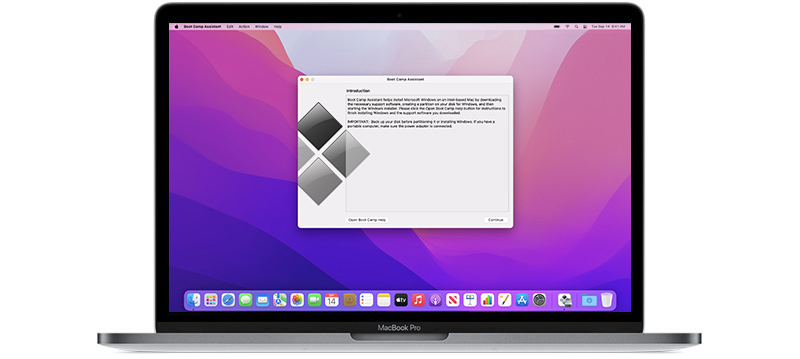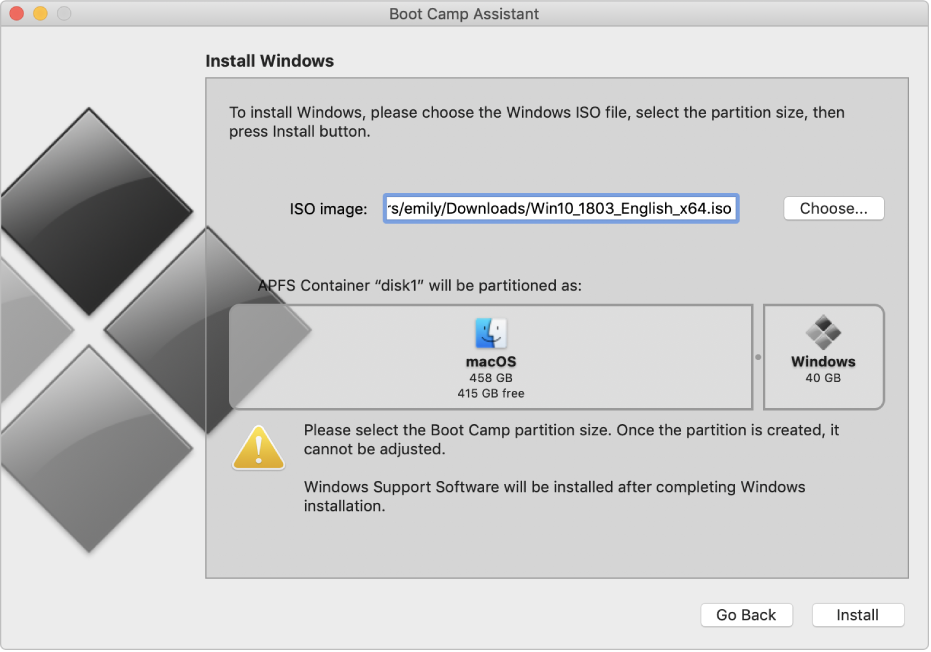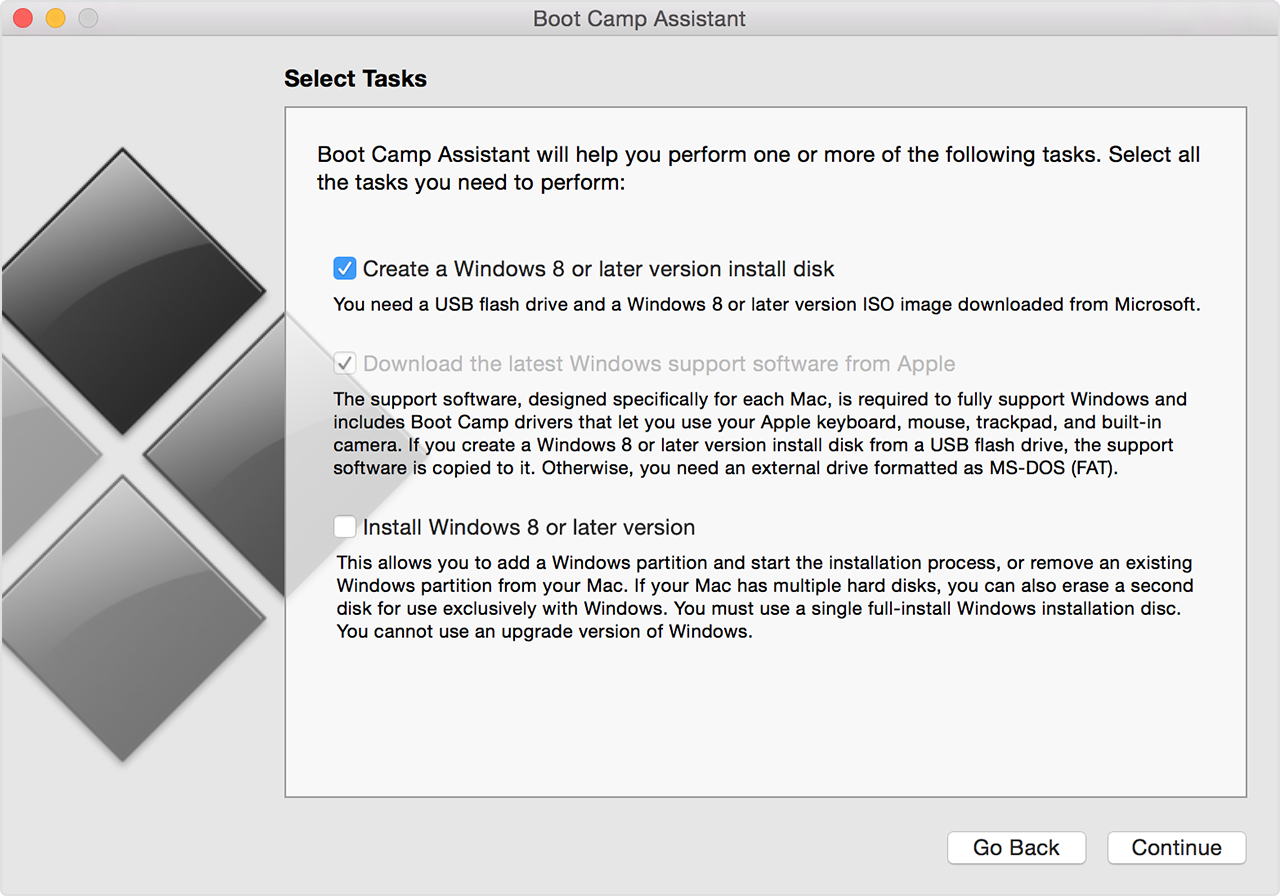Boot Camp Assistant User Guide
Method #1: Create A Bootable Windows 10/8/7 USB on Mac with Bootcamp. As a dual-boot booting tool, Boot Camp Assistant is highly regarded in the field of creating Windows 7/8/10 bootable USB since it was released, it provides the ability to download drivers, re-partition, and add new partition on your Mac. Boot Camp is a utility that comes with your Mac and lets you switch between macOS and Windows. Download your copy of Windows 10, then let Boot Camp Assistant walk you through the installation steps for Intel-based Macs. Get started with Boot Camp.
You can use Boot Camp Assistant to install Windows 10 on your Intel-based Mac.
Newer Mac computers use a streamlined method to install Windows on your Mac. To find out whether your Mac uses this method, see the “Learn more” section in the Apple Support article Install Windows 10 on your Mac with Boot Camp Assistant. If your Mac is an older model that requires an external USB drive, follow the instructions in Install Windows on your older Mac using Boot Camp instead.

Installing Boot Camp drivers is essential for using a Touch Bar and Force Touch with Windows 10 on a Mac, amongst other actions and features. Switching Between MacOS and Windows. Boot Camp allows you to choose the operating system you want to boot up to use during system start, selecting either Windows or Mac OS as desired. Boot Camp is a utility that comes with your Mac and lets you switch between macOS and Windows. Download your copy of Windows 10, then let Boot Camp Assistant walk you through the installation steps. Boot Camp Assistant comes pre-installed on your Mac. How-to: How to install Windows onto your Mac. Update AMD graphics drivers for Windows in Boot Camp.
What you need
The keyboard and mouse or trackpad that came with your Mac. If they aren’t available, use a USB keyboard and mouse.
A full-installation, 64-bit version of Windows 10 on a disk image (ISO file) or other installation media.
You can download a Windows 10 Disc Image (ISO File) from Microsoft.
Sufficient free storage space on your startup drive. For information about the amount of free space needed, see the Apple Support Article Install Windows 10 on your Mac with Boot Camp Assistant.
Before you begin
Before you install Windows, make sure you back up important files.
You can use Time Machine or any other method to back up your files. For information about backing up files, see Back up your files with Time Machine and Ways to back up or protect your files.
Perform the installation
Bootcamp For Mac Os Sierra
On your Mac, do the following steps in order.
Step 1: Check for software updates
Before you install Windows, install all macOS updates.
On your Mac, log in as an administrator, quit all open apps, then log out any other users.
Choose Apple menu > System Preferences, click Software Update, then install all available macOS updates.
If your Mac restarts after installing an update, open Software Update again to install any additional updates.

Step 2: Prepare your Mac for Windows
Boot Camp Assistant prepares your Mac by creating a new partition for Windows named BOOTCAMP and downloading the Boot Camp support software.
Important: If you’re using a Mac notebook computer, connect it to a power source before continuing.
On your Mac, open Boot Camp Assistant , located in /Applications/Utilities.
At the Introduction screen, click Continue.
The system is checked for total available disk space. Older Time Machine snapshots and cached iCloud files are removed to make space for Boot Camp. This process may take a long time to complete (you can click the Stop button to skip this process).
If you have only one internal disk, choose the Windows ISO image, specify the partition size by dragging the divider between the macOS and Windows partitions, then click Install.
If you have multiple internal disks, follow the onscreen instructions to select and format the disk you want to install Windows on and to choose the Windows ISO image.
If you select your startup disk: You can create an additional partition for Windows. Specify the partition size by dragging the divider between the macOS and Windows partitions.
If you select an APFS-formatted disk: You can either create an additional partition on the disk for Windows, or erase the entire disk and create a partition for Windows. If you choose to create an additional partition, specify the partition size by dragging the divider between the macOS and Windows partitions.
If you select a non-APFS-formatted disk: You can erase the entire disk and create a partition for Windows.
If Boot Camp is already present on the disk you select, you also have the option to uninstall it.
Important: You can’t resize the partition later.
When this step is complete, the Windows installer starts.
Step 3: Install Windows
In the Windows installer, follow the onscreen instructions.
When the installation is finished, your Mac automatically restarts using Windows.
Follow the onscreen instructions to set up Windows.
Step 4: Install Boot Camp on Windows
After installing Windows, Boot Camp drivers that support your Mac hardware start installing.
Note: If the support software doesn’t install automatically, you need to install it manually. For instructions, see the Apple Support article If the Boot Camp installer doesn't open after using Boot Camp Assistant.
In the Boot Camp installer in Windows, follow the onscreen instructions.
Important: Do not click the Cancel button in any of the installer dialogs.
If a message appears that says the software you’re installing has not passed Windows Logo testing, click Continue Anyway.
You don’t need to respond to installer dialogs that appear only briefly during installation, but if a dialog asks you to install device software, click Install.
If nothing appears to be happening, there may be a hidden window that you must respond to. Look behind open windows.
When the installation is complete, click Finish.
After your Mac restarts, follow the instructions for any other installers that appear.
When Apple announced its plans to transition the Mac to its own ARM-based silicon and away from the x86 architecture used in Intel Macs, the company listed a plethora of tools for making sure as many applications survive the shift as possible. But while it's helpful that Apple is providing developer tools for adapting Intel Mac apps and virtualization tools for running the apps that won't make the move right away, there's one scenario Apple didn't talk about at all during its keynote: running Windows natively on a Mac.

 Presently, Apple offers a tool in macOS called Boot Camp that facilitates the installation of Windows on another drive or partition, right from macOS. It includes drivers and other boons that make the process a lot simpler than it might be otherwise. Once users install Windows by this method, they're running it natively on the machine just like they would on a Windows laptop from Dell or Lenovo.
Presently, Apple offers a tool in macOS called Boot Camp that facilitates the installation of Windows on another drive or partition, right from macOS. It includes drivers and other boons that make the process a lot simpler than it might be otherwise. Once users install Windows by this method, they're running it natively on the machine just like they would on a Windows laptop from Dell or Lenovo.While virtualization via tools like Parallels or VMWare are usually sufficient for running most Windows apps under macOS, there are some edge cases when the Boot Camp approach is the only option. One of the most common: running Windows PC games, which tend to run more optimally under Windows than they do under macOS, no matter how well done the ports are. (This is, in part, because the games were built with Windows in mind, and it's also because Apple's macOS video drivers emphasize different priorities.)
AdvertisementSo what's to come of Boot Camp in Big Sur, Apple's next version of macOS? And will it be an option on Macs running Apple silicon—the first of which is expected to launch by the end of the year?
We've learned that Boot Camp will not work on Apple silicon-based Macs. This will surely be a surprise to almost no one, of course. You can't expect to just run a game natively out of the box on a totally different architecture.However, Boot Camp will continue to be supported on Intel-based Macs in macOS 11 Big Sur. And while Apple says the transition to Apple silicon from Intel will take about two years, Apple has said that it still has plans to launch new Intel-based Macs that have not even been announced yet. The company also committed to some form of long-term support for Intel Macs.

Boot Camp For Mac Os X
We don't know the fate of Boot Camp beyond Big Sur, but it looks like it's not going anywhere in the immediate future—not if you're using an Intel Mac, anyway. Boot Camp won't be an option for you if you buy an Apple silicon Mac—but you probably figured that already. Still, clarification is nice to have, so here it is.